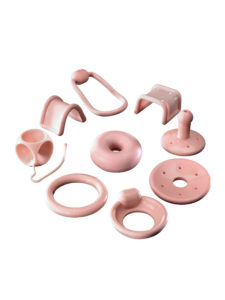
What is a pessary?
A pessary is a small molded device that is inserted into the vagina as a treatment option for pelvic organ prolapse or stress incontinence. When organs such as the bladder, uterus or rectum drop into or outside the vagina, a pessary can help lift and support them back into place. A pessary can also be used to support the vagina, and to treat women who experience stress incontinence.
Pessaries are most often used as a non-surgical approach to pelvic organ prolapse, especially cystoceles (bladder prolapse), uterine prolapse and rectoceles (rectal prolapse). While pessaries can be effective, they do not fix the condition. Instead, they can help support the organ while managing symptoms associated with a prolapse.
Pessaries come in a variety of shapes and sizes, and are chosen to match the condition being treated. Types include the ring, donut, Gehrung, Gellhorn and cube, among others. If a pessary is deemed appropriate, the patient will undergo a fitting to ensure that the correct size is being used, and that the device is comfortable. The goal is to keep the device in place so that it doesn’t fall out, cause undue pressure or discomfort.
Who should use a pessary?
Because pessary placement is a non-surgical approach, it can be used by most patients. It is a particularly good option for women who are:
- Currently pregnant, planning a pregnancy, or who have recently given birth
- Elderly women with fragile health
- Women who have additional chronic health conditions which makes surgery unsafe
- As an interim option for women awaiting surgery
A pessary should not be used by women who have an active urinary tract infection or pelvic infection, or those who are allergic to latex or silicone. It may not be a good option for women with memory loss.
Possible complications
While generally safe and easy to use, complications may arise. However, by practicing good vaginal hygiene and following cleaning instructions, risks can be minimized. It is also important to keep follow-up appointments so that the provider can assess the pessary fit, effectiveness and any patient concerns.
Complications may include any of the following:
- Bloody discharge – blood may be an indicator that the device doesn’t fit properly and is irritating the vaginal walls
- Foul smell – this may signal an infection
- Problems having sexual intercourse – depending on the size and style of the pessary, it may need to be removed before intercourse
- Urine leakage while exercising – the device may not be addressing leakage due to stress incontinence
- Pessary drops or falls out of the vagina
To minimize issues, pessaries are generally replaced every three to six months. Patients will be advised by their provider on how often to change the device, and how to properly clean it.
If you are experiencing pelvic organ prolapse or stress incontinence, contact Urology Austin to schedule an appointment with one of our female urology specialists.
Related links: CooperSurgical, Inc.
